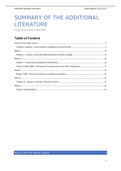Summary
Summary: Additional Literature in the course Social Influence
- Course
- Institution
I have summarized the additional articles and book chapters for the course Social Influence (2022/2023). I have copied the most important information from the articles, so it's all in English. It is a nice addition to my summary of the course book, which can also be found on Stuvia.
[Show more]



